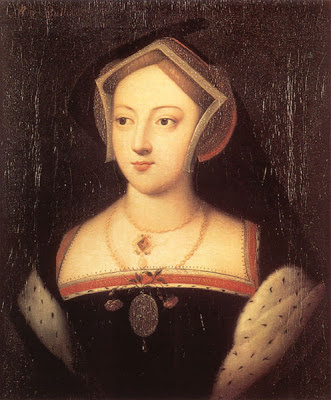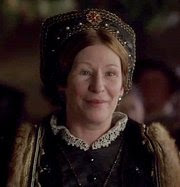 |
| Chaste Women in a Landscape, 1480's by Gherardo di Giovanni del Fora |
There can be little doubt that Anne Boleyn, like any expectant mother of her day, would have had deep concerns and perhaps fears as the days approached her expected delivery date. To add to her anxiety, Anne had a special worry. Though she seemed confident enough, and even boasted publicly, Anne might have harboured a secret fear. Would the child in her belly be a boy?
The importance of the gender of her awaited child cannot be underestimated. By time of the birth of Elizabeth, Henry had lost some of his ardent infatuation with Anne Boleyn. Finally married, new tensions and dynamics were arising in Anne and Henry's relationship. The king was now using a different tone with his queen. Worse, during the later months of Anne's pregnancy, Henry had a brief affair. It seems that much of the court knew about the affair, with some of Henry's men having actively promoted it to spite the hated new queen. Anne was openly jealous, and Henry found it very annoying. Catherine had only rarely opposed him, and Henry was unacquainted with such aggression in a queen--especially his queen. What he may have viewed as an attractive feisty edge when Anne was his sweetheart, was now viewed as shrewish behaviour coming from his wife. Anne had lost the allure of having been the unattainable sweetheart. Now, as the two settled into the daily monotony of marriage, Henry's feelings toward his new queen were changing. Expectations were changing. Henry was not young and idealistic, as he had been the first time around with Catherine, a whole lifetime ahead of him. Henry was in his 40's, and knew from experience how small the window actually was in which healthy pregnancy and childbirth were most likely. Henry knew that only a few years existed in this window, and that time was of the essence. To add to the mix, there were also endless miseries between Henry and Anne and the Lady Mary. Henry demanded that Mary show the respect due his wife, and his daughter flatly refused him. Mary was simmering with resentment toward Anne especially. Initially, Anne had made a few attempts to invite Mary to court, if she was willing to demonstrate a satisfactory level of respect due Anne as queen.
 |
| "I know of no other Queen of England, save my mother. " --Mary Tudor |
Still, even with other problems settling into the new marriage, Anne's first pregnancy was mostly a time of elation for the couple. It seemed that love was rekindled while Anne and Henry awaited the birth of their first child. It was a time of gaiety, and happy planning. Anne was given sumptuous accommodations, and a very valuable bed was presented for her delivery. However--Henry was expecting a son. And thus, his euphoria was not simply based on Anne's pregnancy. What really mattered was that Anne would present Henry with a son. Finally having the woman he had once been deliriously in love with was not nearly enough by that point. Anne had promised Henry during their courtship that she would be the mother of a prince, preferably princes, and not merely a "useless daughter,"as Catherine of Aragon had been. (Catherine had given birth to a baby boy; he would only live for a few weeks.)
It is perplexing as to why Anne was so certain that she would give her king sons. Almost since the inception of their relationship, Anne had carried herself with a haughtiness that is quite astonishing. Astonishing in the fact that for all the love and attention Henry showered on his sweetheart, he was still married. And most of his subjects would not forget for a second that their king was still married to their beloved queen, while carrying on an open affair with Anne Boleyn. Catherine had come to England as a rosy adorable youth, and the English people had fallen in love with the petite smiling girl. Her years as queen had only increased the love and loyalty the English people held for Catherine. Many of Henry's subjects were infuriated with his rejection of their queen, and many were surprisingly bold about their feelings. Though the king would severely punish some of those who openly opposed him, the hatred directed toward Anne took its toll on the couple. Anne had been so outspoken in her response, (perhaps hurt,) she had adopted an stunning new motto, which she displayed Christmas 1530. Ainsi sera, groigne qui groigne translated to: That is how it is going to be, however much people may grumble. It was a provocative slogan, and it did little to warm the people toward the new queen. The new motto and attitude was the polar opposite of Catherine's presentation of humble submission. (Of course Catherine was not always humble, nor submissive, but she did defer to Henry when and wherever possible.) The disparity between the two queens was not lost on the English people, and it inflamed their dislike of Anne Boleyn.
Though Anne had often flaunted a proud, and sometimes outrageous attitude, motherhood was an entirely different and new frontier for her. And surely the intelligent queen must have known that simply willing her body to produce a son was not a sure way to achieve the hoped for result. And yet Anne did carry on as though she knew she carried a prince in her belly. Had she thought that following the advice and rituals of divining women would give her the desired outcome? Perhaps she believed that she would be the 'blessed' queen, and as her reward Anne would be the mother of the king's son. Even Henry's former mistress Bessie Blount was given a good degree of honour and reward for delivering a son. Henry Fitzroy was only a bastard, but he was a boy. Bessie Blount would have received no such special privileges, such as her new title as Mother of the King's Son, if she had borne a daughter.
The diviners and astrologers who visited the king and queen assured them that Anne carried a son. Whether they were sincere in their predictions, or just behaving like any other sycophant who wanted to flatter the king is impossible to say. Henry's own expensive personal physicians had also assured him that Anne carried a prince. It does seem that Henry was confidant his second queen would give him the son he had waited for all those years. Perhaps he could not abide even the thought that Anne would give him a another daughter. A son would be a wonderful reward for the miserable years of battle with Catherine and the church, over the divorce. It would have made up for all the frustrating years of delays before Henry and Anne could be married. Yes, a boy would have made all the difference in the world as far as the king was concerned.
On 26 August Anne entered her time of confinement. On 7 September 1533 Anne's labour pains began. One attendant reported that the labour and delivery had been an extremely painful one. But at the end of it, Anne gave birth to a healthy baby. The child with the signature Tudor red locks was born at three o'clock in the afternoon. The new royal child was said to be beautiful. But it was not the son promised by the astrologers, diviners and physicians. Anne's new baby was a girl. Henry was the father of a second daughter.
Anne was very disappointed; Henry was angry. The mood of the birthing chamber can only be imagined. Finally, the king would pay his queen and new daughter a visit. Henry commented that they were both still "young," and that "boys would follow." Actually, both comments were overly ambitious, and in time would prove to be entirely incorrect. Henry was certainly not "young," at that point. And relative to the age she lived in, Anne was no longer what could be described as youthful. Tudor lifespans were short; and a woman in her 30's was considered past the bloom of youth. The marriage had been postponed for years, and unfortunately Anne was past the optimal age for childbearing. This would be proven, for after Elizabeth's birth, Anne would never deliver a viable child again.
Though Princess Elizabeth was given a beautiful Christening, and the king did warm up to Anne again sometime after the birth, the disappointment in the birth seems to have left a permanent tear in the fabric of the relationship. Elizabeth's birth was perhaps the beginning of the end of her parent's marriage.














